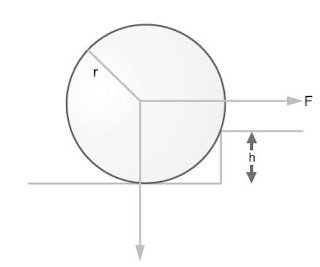1. A point object is placed at (-40,7) cm in front of a concave mirror
of focal length 5 cm having its pole at the origin (0,0). Assuming
the principal axis to be along x-axis, find the position of the
image formed?
::Answer::
2.A wheel of radius r and weight W is to be raised over an obstacle
of height h by a horizontal force F applied to the centre.
Find the minimum value of F.(As shown in fig).

::Answer::
3. A heavy wheel of radius 20 cm and weight 10 kg is to be dragged over a step of height 10 cm, by a horizontal force F applied at the centre of the wheel. Find the minimum value of F.
F = w √(h(2r-h))/(r-h)
= 10 √(10(2(20)-10))/(20-10) = √300
F = 10√3 kg wt
::Answer::
Condition for just slipping, the required condition is
mrω^2 = µmg
r x 4π^2 n^2 =µg
n^2= (µg)/(r4π^2 )
= (0.8x9.8)/(0.1x4x9.8 ) = 2
n=√2 rps or
n = 1.414x60 =84. 84 rpm
::Answer::
Velocity with which ball hits the ground
u = √(2 gh) = √(2 (9.8)(10))
u = 14 m/s
Velocity v with which the ball rebounds
v = √(2 gh) = √(2 (9.8)(2.5))
v = 7 m/s
∆v = v – u
∆v = 7 – (-14) = 21 m/s
a = (∆v )/(∆t ) = (21 )/(0.01 )
a = 2100 m /s^2
::Answer::
The centripetal force (Fc) acting on the satellite revolving round the Earth along the orbit having radius R is given by
Fc=mω^2R
The gravitational force (Fg) acting on the satellite will provide the required centripetal force.
Fg =GmM/R2
Now Fc = Fg
=>mω^2R=GmM/R^2
=>(2π/T)^2R=GM/R^2
=>T^2=(4π^2/GM)R^3.......(1)
Now differentiating (1) w.r to R we get
⇒2TdT=(4π^2/GM)⋅3R^2dR........(2)
Dividing (2) by (1) we get
2dT/T=3dR/R
⇒dT/T=3/2(dR/R)......(3)
Now by the problem change in radius of the satellite is
dR=1.02R−R=0.02R
Inserting this value of dR=0.02R in equation (3) we get the percentage change in time period of second satellite w.r to the time period of first satellite.
% change in time period
=dT/T×100%=3/2(0.02R/R)×100%
=3%


